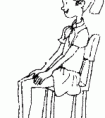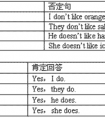用所给词的正确形式填空。1.I(go)forawalkwithmyparentsyesterdayafternoon.2.Ilike(jog)everymorninginthepark.3.Icanseethree (Japan)boysintheclassroom.4.Please-六年级英语
有时,序数词可以用缩写形式来表示。主要缩写形式有。
first—lst
second—2nd
third—3rd
fourth—4th
sixth—6th
twentieth—20th
twenty-third——23rd
其中lst,2nd,3rd为特殊形式,其它的都是阿拉伯数字后加上th。
| 口诀 | 解说 | 举例 |
| 基变序,有规律,后边th加上去 | 在数词后面加th。 | four→fourth |
| 一二三,特殊记,后面字母t,d,d。 | one,two,three特殊变。 | first,second,third |
| 八去t,九去e。整数中的y要变成ie | eight去掉t,nine去掉e。twenty去掉y变成twentieth | eight→eighthnine→ninth |
| f来把ve替。 | five和twelve的ve要变成f。 | five→fifthtwelve→twelfth |
| 若是遇到几十几,只变个位就可以。 | 两位数或两位以上数字只变个位。 | thirty-three→thirty-third |
| 序数词前要加the我们一定要牢记。 | 序数词前必须加the(上述原则中的除外) | thefirstday |
序数词表示法:
一、分数表示法
1. 分数是由基数词和序数词一起来表示的。基数词作分子,序数词作分母,除了分子是“1”以外,其它情况下序数词都要用复数形式。
3/4 three fourths或 three quarters
1/3 one third或a third
24/25 twenty-four twenty-fifths
3又1/4 three and one fourth或 three and one quarter
1/2 a half
1/4 one quarter或a quarter
1又1/2 one and a half
1又1/4 one and a quarter
2. 当分数后面接名词时,如果分数表示的值大于1,名词用复数;小于1,名词用单数。
1又1/2 hours 一个半小时(读作 one and a half hours)
2又3/4 meters 二又四分之三米(读作two and three-fourths meters)
4/5 meter 五分之四米
5/6 inch 六分之五英寸
3. 表示“n次方”的说法:指数用序数词,底数用基数词。
10的7次方 the seventh power of ten(ten to the seventh power)
6的10次方 the tenth power of six(six to the tenth power)
二、百分数表示法
百分数用基数+percent表示
50% fifty percent 百分之五十
3% three percent 百分之三
0.12% zero point one two percent 百分之零点一二
这里的percent前半部per表示“每一”,cent这一后半部分表示“百”,所以百分之几中percent不用复数形式。
三、数量表示法
1. 表示长、宽、高、面积等,用基数词+单位词(meter,foot,inch,kilogram等)+ 形容词(long,wide,high等)表示,或者用基数词+单位词 + in + 名词(length, width, height, weight等)表示。
two meters long或 two meters in length 2米长
three feet high或 three feet in height 3英尺高
four inches wide或 four inches in width 4英寸宽
This box is 2 kilograms in weight.
这个盒子有两千克重。
The city wall of Xi/’an is 12 meters wide and 12 meters high.
西安城墙是12米宽,12米高。
2. 表示时间、距离时,使用含数词的名词所有格形式作定语。
five minutes/’ walk
步行五分钟(的距离)
It/’s an hour/’s ride from my hometown to our university.
从我的家乡到我们大学是乘车一小时的路程。
或:从我的家乡到我们大学需要乘车一小时。
It/’s three kilometers/’ distance from our campus to the Bell Tower.
从我们校园到钟楼有三公里远。
3. 表示温度时,用below zero表示零下温度,温度用基数词+degree(s)+单位词(centigrade摄氏或Fahrenheit华氏)表示。
thirty-six degrees centigrade或 36℃ 摄氏 36度
four degrees below zero centigrade或 -4℃ 摄氏零下4度
Water freezes at thirty-two degrees Fahrenheit.
水在华氏三十二度时结冰。
Water boils at one hundred degrees centigrade.
水在摄氏一百度时沸腾。
这里的单位词在人们都很清楚是什么度量制度时,可以省略。
You are 37℃.(读作 thirty-seven degrees)
你是三十七度。(摄氏)
It/’s seven degrees below zero.
今天是零下七度。(摄氏)
4. 由数词和其他名词构成的名词性短语作定语时,其中的名词用单数形式,名词性短语中各部分间要用连字符“-”来连接。
It/’s a five-minute walk from the library to the playground.
从图书馆到操场需要走五分钟。
She/’s a sixteen-year-old girl.
她是个十六岁的女孩。
5. 表示“比···大(或)几倍”的说法。
This room is two times bigger than that one.
这个房间比那个(房间)大两倍。
The dictionary is four times thicker than that book.
这本词典比那本书厚四倍。
My age is two times older than his.
我的年龄比他大两倍
考点名称:定冠词(the)
- 冠词:
是英语所特有的词类,在汉语中是没有冠词这一说的。虽然它看起来简单,左右不过是a,an,the三个单词,但是正因为中国人的语言习惯大不相同,要彻底掌握和用好冠词,还是不容易的。
冠词分为定冠词(the)和不定冠词(a,an)。它们都置于名词之前,用来说明名词所表示的人或事物。它们不能离开名词而单独存在。 定冠词the的使用情况
A、表示一类人或事物中的某一个或某一些。不论单数名词或复数名词,也不论该名词是否可数,
前面都可以用the。
B、特指某人或某事之前用the。例:The girl under the tree is my sister.
C、指说话人与听话人都熟悉的人或事之前用the。
D、形容词最高级和序数词之前要用the。the best,the first。
E、表示世界上独一无二的事物之前要用the。the Great Wall。
F、重复上文中提到过的人或事用the。- 定冠词的用法口诀:
特指双熟悉,上文已提及;
世上独无二,序数最高级;
某些专有名,习语及乐器。
作为定冠词的基本用法,在下列三种情况下,名词前一定要加the。
第一,当名词所指的东西已经非常明显;
第二,前面已经提到的名词,再次提到时;
第三,当该名词由短语或从句所修饰时。举例如下:
e.g. My friend is waiting for me at the end of the street. (所指的街道说话人和听话人都知道)
e.g. Once upon a time, there was a temple. A monk living in the temple was very kind. (‘temple’在上文提到过,所以再次出现时,要加the)
e.g. This is the book I promised to lend you. (‘the book’由后置定语从句修饰,要加the)
从上面的例子可以看出,这三种情况最根本的要点是当名词有明确所指时或明显被限定时,一般要用the。也就是说,这里强调了the的特指作用。
另外还有两种the的固定用法也强调特指:当用在独一无二的宇宙天体之前(如:the sun, the sky),及用在某些专有名词之前(如:the Yellow River, the Times, the Ministry of Education)等。
- 最新内容
- 相关内容
- 网友推荐
- 图文推荐
| [家长教育] 孩子为什么会和父母感情疏离? (2019-07-14) |
| [教师分享] 给远方姐姐的一封信 (2018-11-07) |
| [教师分享] 伸缩门 (2018-11-07) |
| [教师分享] 回家乡 (2018-11-07) |
| [教师分享] 是风味也是人间 (2018-11-07) |
| [教师分享] 一句格言的启示 (2018-11-07) |
| [教师分享] 无规矩不成方圆 (2018-11-07) |
| [教师分享] 第十届全国教育名家论坛有感(二) (2018-11-07) |
| [教师分享] 贪玩的小狗 (2018-11-07) |
| [教师分享] 未命名文章 (2018-11-07) |

![Yesterdayhe hiskeys,sohecan'tgohome.[ ]A. losedB. lostC. losesD. losted-六年级英语](http://www.00-edu.com/d/file/ks/4/1/51/2019-08-24/small56b740c860ea72171119a747c83813f51566588119.gif)

![I ____________ to the store on Sunday. [ ]A. goB. went-五年级英语](http://www.00-edu.com/d/file/ks/4/1/51/2019-08-24/smallb5041caaeb2961272b3d1491492e45251566588603.gif)


